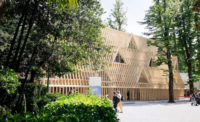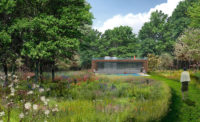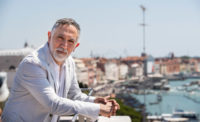One of the unexpected effects of visiting Venice during the pandemic is realizing that beneath the rhetoric about declining numbers of native inhabitants, rising rents and intrusive cruise ships, Venice is still surviving. The population on the island of Venice may have dropped from 140,000 in 1960 to around 50,000 today but as a city it endures. The narrative was picked up in the “Co-habitats” section of the Biennale exhibition in the Arsenale, which explores democracy and development in cities. One of the exhibitors, Sandro Bisà, lives on the island of Burano, which sits in the middle of the Venetian lagoon. He has worked with Modem, an office based in California to explore the resilience of Venice and the lagoon it sits in.
His discoveries are surprising. With urban authorities across Europe using the lockdown as an opportunity to pedestrianize city centers and encourage use of public transit, car-free Venice is suddenly and unexpectedly looking like a city of the future. La Serenessima, as it is known, has an inhabited core where everyone uses the (admittedly expensive) public vaporetto, or water bus, system to traverse its canals. The periphery is defined not by tiresome battles over land use but by massive infrastructure construction to host 21st century geo-engineering: the dream of urbanists. In October 2020, Venice’s new robotic system of flood defense—MOSE—was successfully triggered for the first time, protecting Venice from a high tide, lessons perhaps for other coastal cities. (The system clearly has had its teething problems. In December, operators failed to turn on the defenses early enough, leading to an inundation widely covered in the media.)
Other major problems persist of course, but Venice—as the installation Bisa curated makes clear—is emerging from the lockdown stronger than ever. The temporary cancellation of cruise liners seems to have uncorked the impasse that exists between local, regional and national factions over support for—or objection to-—these enormous chunks of steel that have been entering Venice. (The national government would like a new international ferry port built outside the lagoon, while the local government believes the commercial port at nearby Marghera should be expanded.) The city’s new flood defenses are part of large-scale land improvements: threatened waterfronts have been raised and more defensive sea walls built.
One particular joy of the Biennale is finding the good collateral exhibitions outside the official ones in the Arsenale and the Giardini. They are invariably hosted in historically significant structures in distant neighborhoods, and while the visitor must navigate the labyrinthine street and canal systems, the rewards are great. This year, either by coincidence or by some strange agency we call the zeitgeist, these exhibits had a futuristic flavor. The Lithuanian Space Agency took up residence in the church of Santa Maria dei Derelitti in Castello, a once working class district that grew up around a naval dockyard. With pseudo-scientific language, the show’s creators described how they’d make a planet from human bodies. The Baroque statues of Giusto Le Court were surrounded by this tongue-in-cheek space project, where human figures on digital screens slowly rotated through space towards each other to evolve into a new celestial body.
Indeed, the Biennale is a place for considering futures, both whimsical, like the Lithuanian Space Agency, and the more serious. In the Squero Castello, not far from the Arsenale, French firm Coldefy & Associates showed their plan and models of Tropicalia, a proposal for the largest tropical greenhouse in the world. With a pioneering, double-skinned ETFE dome, the 215,000 square-foot conservatory would be constructed in the Pas de Calais region of France.
Another exhibition called Mutualities at the Spazio Rava Palazzo is a collection of twelve future scenarios: a sky garden, for example. From the configuration of the buildings to the decision of what trees to plant, each scenario has been augmented with the considered use of digital technology. Created by SPACECOUNCIL, a German/Singaporean practice, and funded by Hochtief, the engineering-led infrastructure group, the small exhibition is a genuine research project that we will one day see built, in one form or another.
The architecture biennale is not simply an artistic event. During its six-month run (until November 21st), Venice itself rediscovers its role—as a onetime center of world trade and, for this time, as a nexus of culture. A majlis is a place for council meetings in nomadic communities of the Middle East and is often a temporary structure. In the garden of the monastery on the Isle of San Giorgio Maggiore, the Qatari Dutch cultural organization, Caravane Earth, has built a modern majls, designed by Simón Vélez and Stefana Simić. With it, the curator, Dr. Thierry Morel, has taken advantage of the extra year granted by the COVID delay to create an amazing celebration of Venice’s historical position as a fulcrum between West and East.
Around the majlis—shaded by newly-planted pomegranate and jujube trees—a monastic garden has been transformed, with each planting chosen to acknowledge Venice’s role as a conduit of botanical exchange between East and West. Inside a renovated gallery of the monastery stands an exhibition of artefacts, which wouldn’t look out of place at the Metropolitan Museum of Art, including the mamluke carpet borrowed from the city’s Scuola di San Rocco. Originally brought to Venice from Egypt in the early 16th century, it is a work which is key in understanding Venice as a vital point of communication and trade.
The modernity of Venice is often ignored. In 1910, the futurist artist, poet and impresario F.T Marinetti came to the city and threw leaflets from the top of St. Mark’s Campanile into the square below, repudiating ancient Venice, demanding that its lesser canals be filled in and calling on the city to become a great port again. He never got his wish, of course. But today, as one sadly leaves Venice, one can see in the distance the oil refinery of Marghera, just a short swim from the ancient island. It was announced this year that by 2024, Marghera will be one of the largest bio-refineries in the world, producing 420,000 tons per year of HVO (Hydrotreated Vegetable Oil) biofuel. On its periphery and, during the Biennale, in its hidden corners, Venice is a city of the future.









Post a comment to this article
Report Abusive Comment